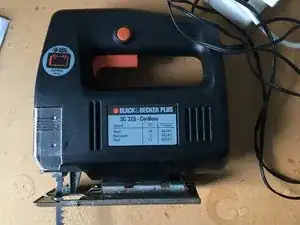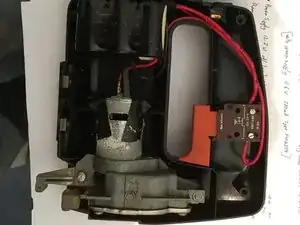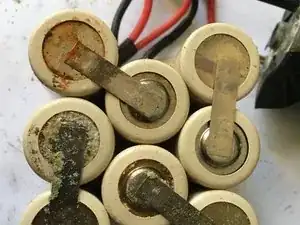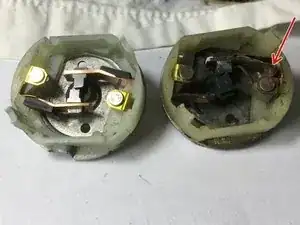Introduction
The jigsaw's battery charger was satisfactory (12.7v 5W) but the jigsaw showed no indication of working.
The jigsaw was disassembled to show two faults (1) there was no voltage from the NiCad battery pack, and (2) the DC motor had a brush arm failure.
Both these faults were cured with the help of a motor from a scrap Cannon Pixma printer(ebay)
Tools
-
-
Suggest taking photos as you go to aid later re-assembly. You can never have too many photos! To open case, undo 5 cross-head bolts on side. Undo 2 flat-head bolts at base to remove adjustable foot. Slide off transparent safety shield. (For safe working also remove blade).
-
Gently ease the two halves of casing apart. You may need to remove an advertising sticker).
-
Everything can now be pulled out from the casing. (Take care not to loose the two captive nuts at the base.)
-
-
-
With scissors you can cut the black plastic covering off the 8-cell battery pack, being careful not to short the batteries. Note: batteries are spot welded together in series to give a nominal 9.6v. (8x1.2v)
-
Using a multimeter, the measured voltage where the leads exit the pack should read around 9.6v (nearer 11v when fully charged). If not measure the voltage of each individual cell. In my case, all measured about 1.3v except for one faulty cell that gave 0V.
-
I removed the faulty cell, by breaking off the spot welds (eg with long nose pliers) on the top and bottom and breaking the glue bonds. (You could leave the cell in place if it is revivable)
-
You could replace the faulty cell(s) or try to revive. I revived by using a 12 volt car battery for less than a second by just instantaneously touching the positive to positive and at the same time negative to negative. This should give a little spark (wear goggles).
-
The reason for the quick relatively high voltage (eg 12V) charge is to break any dendrites that are causing any internal short.
-
Then try charging this battery in a standard NiCad/NiMH battery charger (about 2V per cell) for an hour or two. If it takes and holds the charge for 48hr, it can be returned to the battery pack (see below)
-
A new or revived battery can be glued and soldered back into place in the battery pack. To solder, clean up all the surfaces with sand paper. Add flux and solder (30W iron?) to all the surfaces until fully wetted. If the solder doesn't flow/wet nicely, repeat with sand paper and flux. (Do not over-heat battery).
-
When satisfactorily wetted, solder back the connections to cell. Check you now have a nominal 9.6V across the leads. Replace black plastic covering using some insulation tape to repair the earlier cut.
-
-
-
In my case the battery pack was not the only problem, as the jigsaw still wouldn't work.
-
I had to remove the DC motor from the gearbox. Remove 4 bolts from gearbox cover and detach, (you can pull out /clean gear wheel and cam- don't lose the cam bearing). Then undo two bolts at the top to release the electric DC motor.
-
With a multimeter, I measured the resistance across the motor's terminals to find it was open circuited. I removed the terminal block (image) from the motor and noted that it had been repaired before (explaining why it was easy to dismantle) as one of the brush arms had fractured (see red arrow on image) and had been glued back in place.
-
I attempted to repair the repair, replacing the corroded electrically bridging steel sheet with some new copper sheet to bridge the gap between the terminal post and the glued-in brush arm, but although it worked, it wasn't reliable.
-
I obtained a near identical looking motor ( QK1-1500 from a scrap cannon printer) and removed the terminal block assembly which also contained the brushes. As you can see from the image, the newer one on the left is virtually identical. To remove the terminal block, it was necessary to file away the six bent-over tabs with narrow diamond files.
-
I did consider using the 'new' motor as it was, but I didn't know its wattage and I didn't have a bearing puller to swap the drive cogs which weren't identical.
-
To replace the terminal/brush assembly, it was necessary to pull and hold back the brushes so they fitted over the commutator.There are some holes for this purpose. (I used two 40mmx2mm dia rods which can be pulled out from the outside when in position so the brushes spring back onto the commutator). The assembly was glued/taped in place.
-
Electrical connections to the motor may need to be soldered or changed if spade connectors are a different size.
-
An old Black and Decker cordless jigsaw SC325 was returned to working order by reviving the old battery pack and replacing the terminal/brush/bearing assembly from another motor (TD426624 QK1-1500 see ebay) from a scrap Canon Pixma printer.




